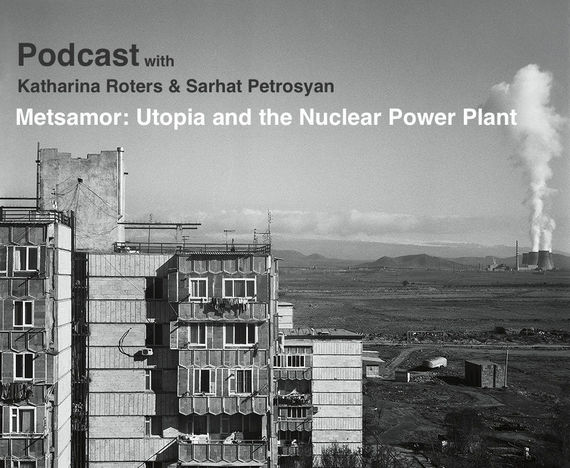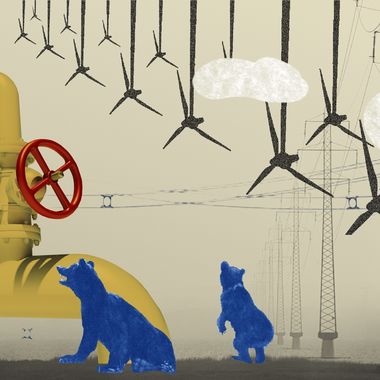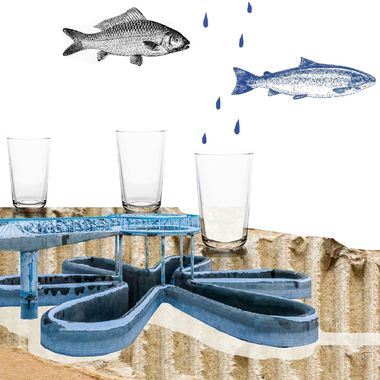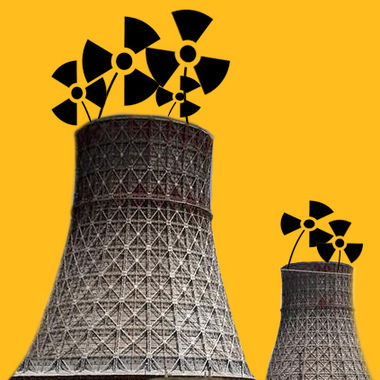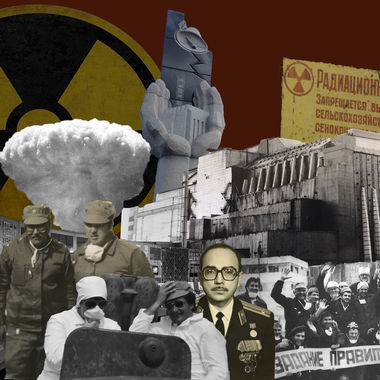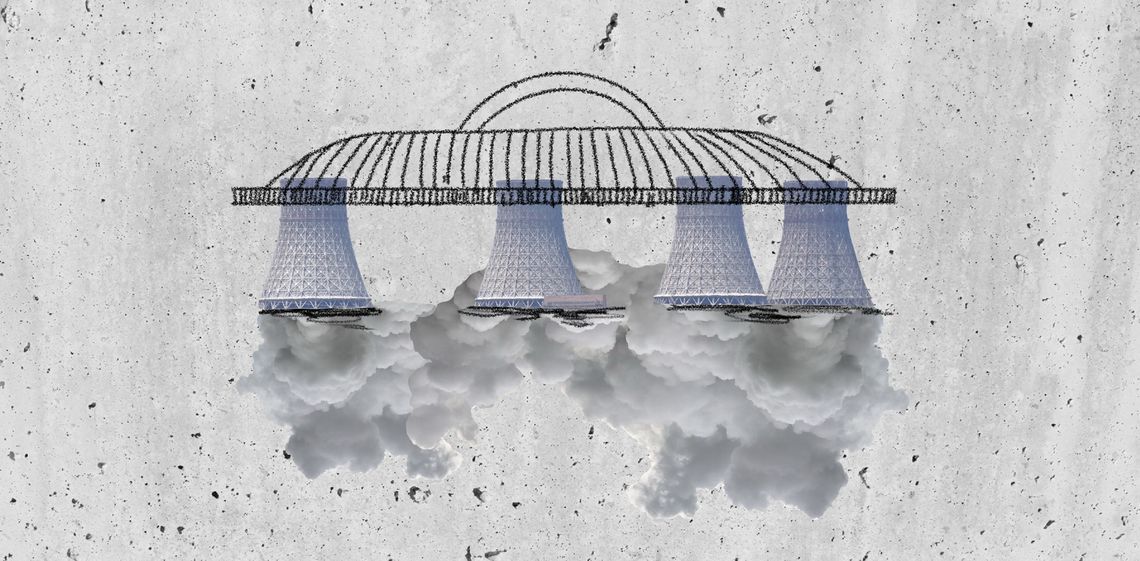
Illustration by Armine Shahbazyan.
The Armenian Nuclear Power Plant (ANPP) in Metsamor holds great importance for Armenia’s energy security; it also poses dangers that are often overlooked. The focus has been that the nuclear plant is located in an active seismic zone; however, less public scrutiny has been paid to its ongoing environmental impact.
Metsamor has also been weaponized by Azerbaijan. In July 2020, the Azerbaijani defense ministry even openly threatened to blow up the plant with a missile strike, though they backtracked after the statement made headlines around the world. The plant supplies about 40 percent of Armenia’s annual electricity generation, and losing it at the current time would leave Armenia in a vulnerable situation. For the longer term, however, Armenia has some choices to make.
In the fight against climate change, there is a global quest to replace the energy currently generated from fossil fuels with renewable sources. Nuclear energy was once heralded as an opportunity to reduce carbon emissions, but the 2011 Fukushima Daiichi disaster in Japan was a turning point. After the event, Germany announced that it would phase out the country’s nuclear plants. Italy had already completely phased out its nuclear plants. Belgium’s deadline to do so is 2025. Some nuclear power plants are also being shut down in the U.S. as they reach the end of their design life. With hydropower plants, wind farms and solar energy generally considered to leave a smaller carbon footprint and relatively safer for people and the environment, nuclear energy is facing a dilemma. While it can provide substantial amounts of energy with low carbon emissions, its environmental impact is not neutral.
In the mid-20th century, there was a boom in nuclear energy production. At the time, it was projected to become the energy of the future, with a famous claim that it would be “too cheap to meter”. However, the Three Mile Island and Chernobyl disasters cast a shadow over the nuclear dream. Just as enthusiasm was beginning to gain momentum, the accident at Fukushima revived fears among the public. New nuclear power plant projects were halted around the world for a while; however, some have since resumed. China is planning to build 39 new reactors in the future. Even European countries like the UK and Finland are planning the construction of new reactors.
However, the world remains divided over nuclear energy. Proponents argue that it is safe if regulated properly. Opponents claim that the issues of radioactive waste and risks of a meltdown do not outweigh its potential to reduce carbon emissions.
Kicking the Can Down the Road
The Armenian Nuclear Power Plant is considered to be one of the world’s most dangerous nuclear plants, as it is located in one of the world’s most seismically active regions.
The most recent big earthquake happened in 1988 in northern Armenia, hitting a magnitude of 6.8 on the Richter scale. Although the nuclear plant, located 75 km from the epicenter, was not damaged, Soviet authorities decided to shut it down in early 1989 due to security concerns. After independence, facing an energy crisis amid a blockade from Azerbaijan and Turkey, Armenian authorities decided to reactivate the second, newer block of the power plant in 1995. It is very rare to restart a nuclear reactor once it has been shut down. Local and international experts were invited to evaluate safety risks, and it was deemed safe to restart the reactor.
Unit 1 of the power plant had begun operating in 1976 and Unit 2 in 1980, with a 30-year design life. With the six-year intermission, it was supposed to be decommissioned in 2016. However, in 2014, the Armenian government decided to extend the life of the power plant for an additional 10 years, until 2026. Now, with that new deadline five years away, the government is considering prolonging the operation of the power plant until 2036, if refurbishments, with the support of Russia, prove that it is possible for the plant to operate safely. Russia provided a $270 million US loan to Armenia to extend the life of the ANPP. Despite the fact that the nuclear plant poses dangers, Armenia is accumulating debt to maintain it.
Armenian authorities claim that the ANPP can withstand an earthquake up to a magnitude of 8.0. It is considered unlikely that an 8.9 magnitude earthquake, like the one that caused the tsunami in Fukushima, would hit Armenia in that time frame. However, one source says that the power plant was originally designed assuming a maximum 7.0 earthquake, considerably less than the theoretical maximum of 8 or 9 in the area. Nevertheless, a post-Fukushima stress test in 2011 reassured authorities about immediate risks.
Environmental Worries
Calls from the EU and the U.S. to shut down Armenia’s Nuclear Power Plant are largely based on seismic risks. If a disaster were to happen, it could be devastating for the entire region. Yet the environmental impact of the power plant, during its regular operation, is also a reason for concern for a small country like Armenia, given the plant’s proximity to major agricultural areas and water systems.
Nuclear power plants emit low levels of radiation. Scientists have divided opinions over the effects of low-level radiation over time. Numerous scientific studies have shown an increased rate of cancer among people who live near nuclear power plants. Radiation can ionize molecules and damage DNA. More research is being done to determine the effects of low levels of radiation on the environment.
Some experts claim that, although officially radioactive releases from Metsamor are within the norm and even many times lower than the maximum allowable norm, there is no data regarding the real rate of emissions. While radioactive particle releases are low during operation and do not pose an immediate danger, how they are monitored and measured is an issue.
Nuclear power plants also pose a threat to nearby water systems. Water is essential for all nuclear power stations; it’s used to cool their heat-generating radioactive cores. The water becomes contaminated with radionuclides, which are unstable atoms with excess energy, during the cooling process and must be filtered to remove as many radionuclides as possible.
The filtered water is then stored in huge steel tanks or released into nearby bodies of water. As massive amounts of water are required by every plant, most nuclear facilities are built on coastlines—or in the case of Chernobyl, surrounded by lakes or rivers. That way, filtered wastewater can be discharged into a water body once it has been assessed and confirmed to be safe. The ANPP is located near the Sevjur River, sometimes called the Metsamor River, which flows into the larger Araks River.
Energy expert Emil Sahakyan is concerned that the cooling system operation can pose a threat to nearby water sources. The cooling system uses water from the Sevjur River. Wastewater is accumulated during the operation of certain parts of the nuclear plant. The wastewater is diluted into clean water to reduce the concentration of radionuclides to an acceptable level. The water is then released into the Sevjur River and can be used for irrigation. Sahakyan notes that it must be measured whether the wastewater has been diluted enough to be released into the river. He claims that he has not seen that the process of discharging wastewater into the river is monitored.
The Indian Point nuclear power plant in the state of New York was facing similar issues. Water carrying low levels of radioactive particles, which were not considered to be hazardous, flowed from the plant into the Hudson River. The cooling system of the power plant was deemed more harmful as it sucked water in from the Hudson in a process that did not protect fish and the ecosystem. Besides, the plant’s blast radius covered Manhattan, which would make a meltdown cataclysmic. The final reactor of the plant was shut down in April 2021. The ANPP is also releasing water carrying radioactive particles into the water system and there is a concern that the amount of the radioactive particles in the water is not properly measured. The nuclear plant also uses up the already-scarce water resources of the Ararat Valley.
Besides low levels of radiation and releasing contaminated water into the surroundings, there is also the big issue of radioactive waste. The nuclear waste of the ANPP was transported to Russia during Soviet times, however, since the railroad to Moscow was shut after independence the radioactive waste in Armenia has been sitting in interim storage containers due to the lack of safe disposal. Containers of radioactive waste can start leaking into the soil and water sources.
The permanent storage and management of nuclear waste, which may take hundreds of thousands of years to lose its radioactivity, is an issue many countries that produce nuclear energy face. The most promising approach has been to find a geologically stable area in which to store it deep underground. It is unlikely that such a site could be found in Armenia due to seismic activity, a lack of specialist surveys, trained personnel and sufficient funding.
In 2011, the Operational Safety Review Team (OSART) of the International Atomic Energy Agency (IAEA) conducted monitoring of the ANPP and presented 14 recommendations to improve the safety of its operations. Four of those recommendations concerned radioactive waste management. In 2013, the OSART representatives noted that the recommendations had not been enacted. Environmental activists report that waste management issues are still not resolved.
There are also concerns about the decommissioning of Unit 1. The unit has to be taken apart and encased in a structurally long-lived material (this is not considered an ideal solution) and/or buried underground as some experts in Armenia claim; the whole process can take up to 50 years.
When the Armenian government decided to prolong the operation of the second block of the ANPP, some of the parts from Unit 1, which were still usable, were used to refurbish Unit 2. However, experts warn that equipping and renovating Unit 2 does not solve the safety concerns of the ANPP. Operating a refurbished power plant is not the same as operating a new one. During operation, metals change their structure under radiation and weaken. It is not possible to check everything; only the reactor, circulation rings and generator are being checked.
Armenia is a small country. The capital Yerevan, where one-third of Armenia’s population lives, is only 36 kilometers away from the power plant. The Ararat Valley, which is the fertile crescent of Armenian agriculture is near the nuclear plant. The plant also neighbors rivers and underground water sources. Hence, the power plant poses contamination risks for the population, wildlife and plants in Armenia.
Environmentalists also note that there is no open discussion about the issue of radioactive waste and emissions in Armenia. We contacted the ANPP for comment on the environmental impact of the nuclear plant and certain monitoring procedures, but unfortunately after several attempts did not receive a reply.
Armenia’s Dilemma With its Nuclear Plant
Nuclear power plants are large and costly to build. The electricity they produce is not cheap. Although catastrophic accidents are rare, safety depends on strict adherence to regulations. The radioactive waste produced by nuclear plants is dangerous and virtually eternal. But nuclear plants are also a source of low-carbon energy and provide some self-sufficiency for countries like Armenia.
Armenia is a landlocked country without many natural resources. While it imports gas and most of its oil from Russia, its current generation capacity is adequate for domestic demand. The ANPP produces about 40 percent of Armenia’s electricity, while the remaining 60 are produced by hydropower plants and the thermal power plant in Hrazdan․ The overall percentage of renewable energy produced by Armenia is less than 1 percent.
Whether it is 2026 or 2036, at some point, the ANPP will need to shut down. What’s more important is what will come next. Armenia could set a date to phase out nuclear energy and start replacing the current output of the ANPP with renewable energy. Renewable energy is cheaper and faster to build. It is safer for people as well as the environment. It actually increases energy independence as it does not rely on uranium imports and outsourcing waste management. Instead of building another reactor, Armenia should ramp up its investments in renewable energy. A focused plan for the coming five years can ensure that the ANPP is eventually shut down on our own terms. Failing to address the imminent issue is the path that leaves us vulnerable.
Also see
Laying Off the Gas: Energy Security in Armenia
By Yelena Vardanyan
Diversifying Armenia’s energy sources is a strategic need of national importance. The coming decade presents an opportunity to turn direction and tackle the considerable obstacles facing the country. Strong political commitments and a focused approach are needed to make real progress.
Armenian-EU Energy Cooperation
By Anna Barseghyan
One of the most important dimensions of Armenian-EU cooperation is the energy sector. The EU has expressed a willingness to support Armenia in designing an energy strategy and policy, including security and diversification of the energy supply.
Armenia Takes On New Waste Management Practices
By Viktorya Muradyan
New colorful waste sorting bins appeared in different districts of Yerevan late last year. By the end of February, the capital will have about 135 new waste sorting locations giving residents the opportunity to dispose of their glass, plastic and paper waste in their courtyards.
Global Water Scarcity and Its Implications for Armenia
By Paruyr Abrahamyan
In this comprehensive piece on water security, Paruyr Abrahamyan provides an in-depth overview of global water scarcity, how this will potentially compound the already-complex problems facing the South Caucasus and makes a number of recommendations.
More on Metsamor and nuclear power
The Past, Present and Uncertain Future of the Metsamor Nuclear Power Plant
By Justin Tomczyk
Armenia’s Metsamor Nuclear Power Plant, located in a seismically active area, was designed to be decommissioned in 2016. It has been a topic of debate and discussion in Armenian society for decades. Justin Tomczyk takes a closer look.
Environmental Protection and Pandora’s Box to Independence
By Ani Garibyan
Even after Armenia gained independence from the Soviet Union, it is still reliant on many Soviet-built (sometimes very poorly built) infrastructure that can prove to be dangerous to local communities, flora and fauna, as well as the country’s economy and national security.
Chernobyl: The Doctor, the Soldier, the Cook and the Nuclear Disaster
By Arpine Haroyan
The 1986 Chernobyl Nuclear Power Plant accident was considered the worst nuclear disaster in history. It exposed hundreds of thousands of people to high levels of radiation, killing dozens and affecting millions across Europe. Experts from all over the Soviet Union were sent to “liquidate” the effects of the radiation. Among them were several thousand Armenians.
